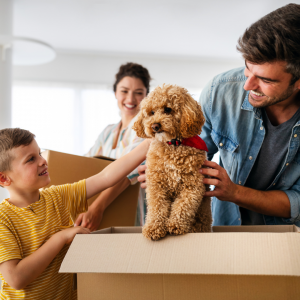
When kids head back to school, the shift in household routine can be significant—not just for parents, but for pets too. After a summer of activity, attention, and companionship, pets may suddenly find themselves alone in a much quieter home. For families in Edmonton, this time of year is an opportunity to reset—not only for school routines, but for how we care for our pets during these changes.

How Pets React to the School-Year Shift
The house gets quiet. The kids leave earlier. Walks, playtime, and meals might shift to different hours. These changes—though normal for humans—can be unsettling for pets.
Signs your pet might be struggling include:
- Barking or whining when the house empties
- Destructive chewing or bathroom accidents
- Pacing, hiding, or reduced appetite
- Excessive excitement when family returns home
Understanding how your pet responds to routine changes is the first step in helping them adapt.

Simple Routine Resets That Make a Big Difference
Start by adjusting your pet’s schedule a few days before school begins. Gradually shift feeding and walk times to align with the new daily rhythm. Practice short separations so your pet isn’t surprised by long, quiet days. Morning enrichment—like puzzle toys or a stuffed Kong—can help redirect energy and provide mental stimulation after the family heads out.
After-school rituals are just as important. Whether it’s a walk, play session, or some quiet cuddle time, these moments help pets reconnect with their people and feel secure in their new routine.
These small changes add up, and they’re especially helpful in homes where pets are used to constant companionship.

Create a Pet-Friendly Home That Supports Their Well-Being
Your home plays a major role in how your pet experiences routine shifts. A cozy resting space, access to natural light, and a few engaging toys can make alone time more manageable. Families who are moving or settling into a new home this fall can also plan ahead by considering layouts that support pet routines—like mudrooms for easy outdoor access or quiet corners for daytime naps.
As a real estate team that advocates for pets and families, we often help Edmonton buyers and sellers think through these needs. A pet-friendly space can make daily routines smoother—not just during back-to-school season, but all year long.

Tips for a Stress-Free Transition
Set your pet up for success with these thoughtful back-to-school strategies:
- Use departure cues wisely: Keep goodbyes calm and low-key. Making a big fuss can increase your pet’s anxiety when the house empties.
- Keep background noise on: Soft music, TV, or a white noise machine can make your pet feel less alone during quiet daytime hours.
- Rotate toys regularly: Keep solo playtime interesting by swapping out toys every few days to maintain novelty and engagement.
- Offer treats with purpose: Use food puzzles or timed feeders to break up long stretches of alone time with something rewarding.
- Keep energy in check: A brisk morning walk or quick backyard game before the school run can help pets stay relaxed while you’re away.

A Smooth School-Year Transition Starts at Home—for Pets Too
Adjusting to the school year isn’t just about packing lunches and setting alarms—it’s also about supporting every member of the family, pets included. With a little planning and a lot of love, your home can remain a calm and comforting space for your furry companion.
These back-to-school routine tips for pets in Edmonton are simple, actionable ways to reduce stress, build structure, and help your pet thrive during this seasonal shift. And if you’re thinking about a move, Dave Ozubko Real Estate Team here to help you find a home that fits every member of your family—paws included.













